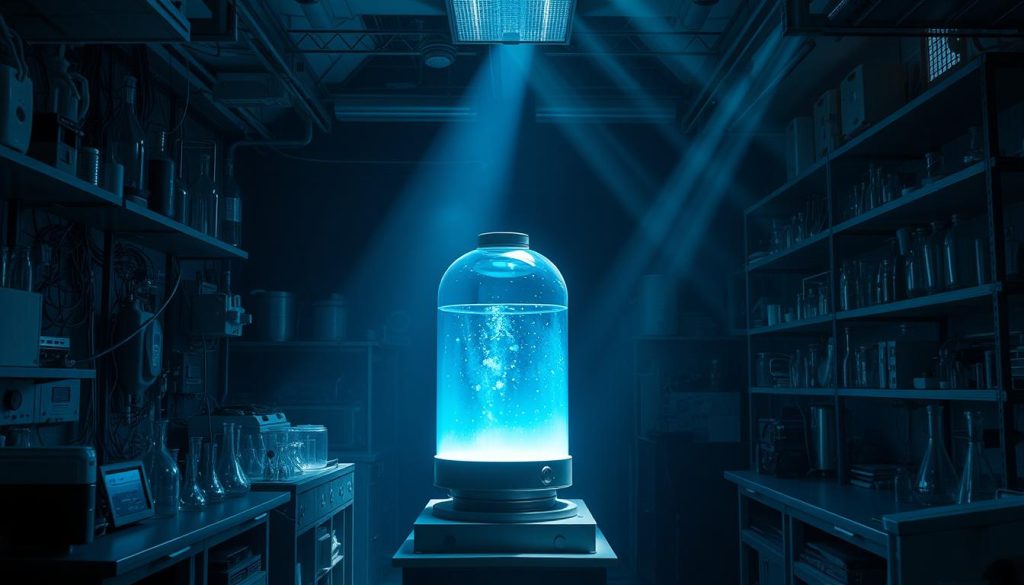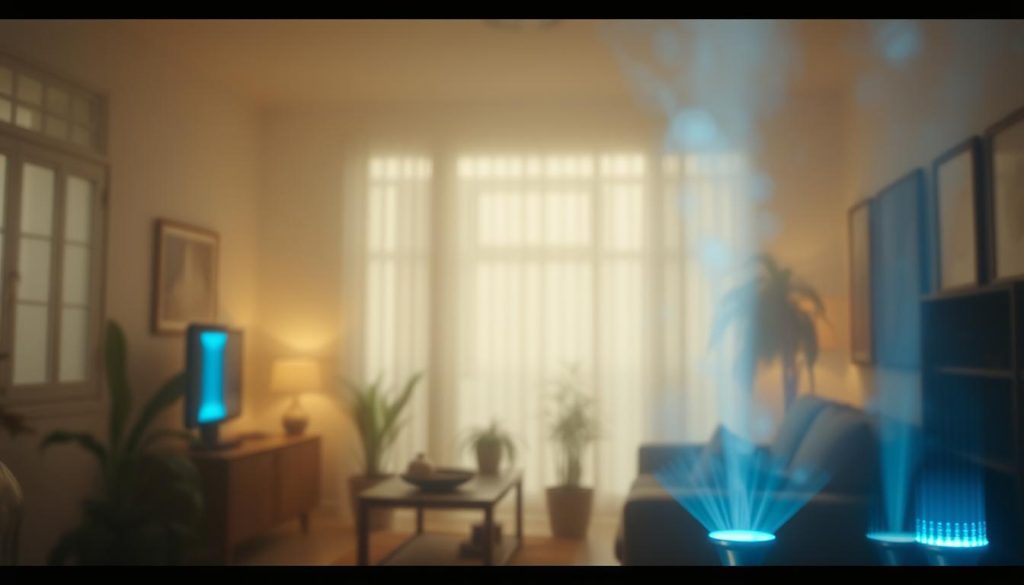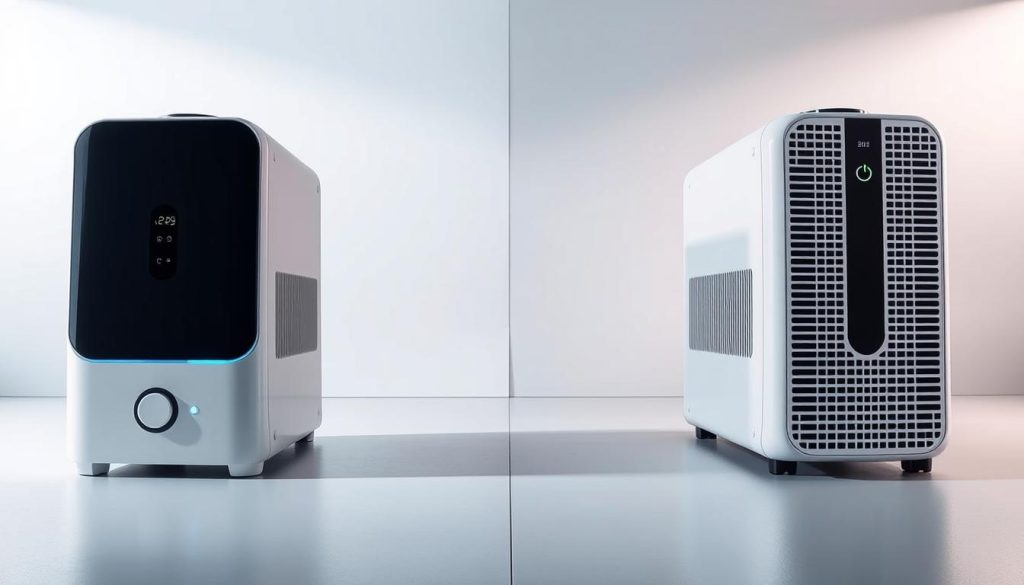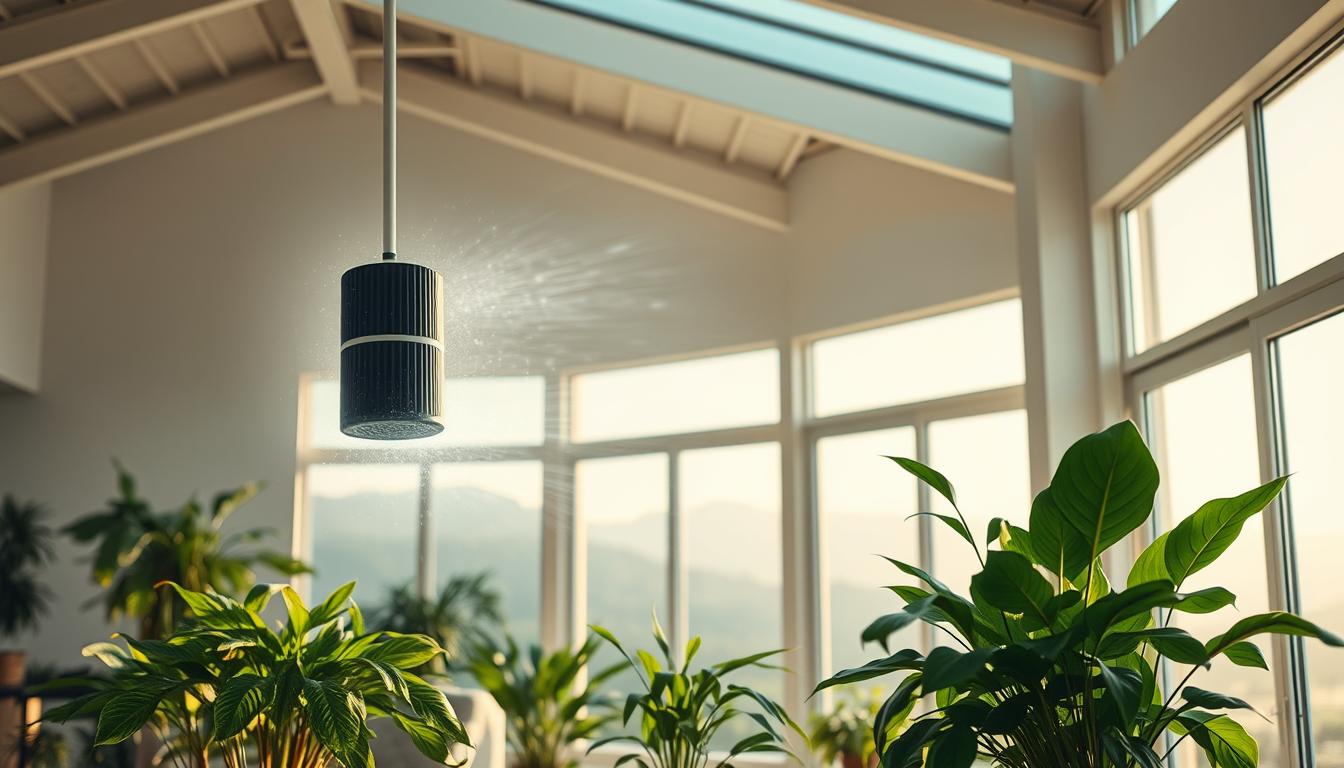In our quest for optimal health and well-being, we often overlook one crucial factor: the quality of the air we breathe. Poor indoor air quality can lead to a host of health issues, from respiratory problems to allergies and even mood disorders. Fortunately, nature has provided us with a powerful tool to combat these issues: negative ions. By harnessing the benefits of negative ions, we can effectively purify the air in our homes and offices, creating a healthier and more refreshing environment.
Negative ions are tiny, electrically charged particles that occur naturally in the environment, particularly in areas like waterfalls, forests, and beaches. These invisible allies work tirelessly to improve air quality by neutralizing pollutants, allergens, and other harmful particles. As we explore the science behind negative ions and their impact on our well-being, you’ll discover how incorporating negative ion generators into your space can transform the very air you breathe, leading to a cleaner, healthier, and more invigorating atmosphere.
What Are Negative Ions and How Do They Work?
Negative ions are tiny, electrically charged particles that play a crucial role in maintaining air quality and promoting overall well-being. These invisible molecules are naturally present in the environment and have a profound impact on the air we breathe. Let’s dive into the science behind negative ions and explore their natural occurrence in various settings.
Understanding the Science Behind Negative Ions
Negative ions are created when air molecules gain an extra electron, giving them a negative electrical charge. This process occurs through natural phenomena such as lightning, waterfalls, and even the movement of air over certain surfaces. When negative ions are present in the air, they attract positively charged particles, including allergens, pollutants, and dust, effectively removing them from the atmosphere.
The science of negative ions revolves around their ability to neutralize harmful particles in the air. By attaching themselves to these particles, negative ions cause them to become heavier and fall to the ground, thus reducing their concentration in the air we breathe. This process helps to purify the air and create a healthier indoor environment.

The Natural Occurrence of Negative Ions in the Environment
Negative ions are abundant in nature, particularly in environments known for their refreshing and invigorating qualities. Some of the most notable natural sources of negative ions include:
- Waterfalls and moving water bodies
- Beaches and coastal areas
- Forests and green spaces
- Mountains and high-altitude regions
The concentration of natural negative ions in these environments can be significantly higher compared to indoor spaces. The following table illustrates the typical negative ion concentrations found in various settings:
| Environment | Negative Ions per Cubic Centimeter |
|---|---|
| Waterfalls and Beaches | 10,000 – 50,000 |
| Forests and Mountains | 5,000 – 20,000 |
| Cities and Urban Areas | 100 – 500 |
| Indoor Spaces (Homes and Offices) | 50 – 200 |
The presence of natural negative ions in these environments contributes to the refreshing and rejuvenating sensation often experienced when spending time outdoors. By understanding the science behind negative ions and their natural occurrence, we can appreciate their significance in promoting cleaner air and enhanced well-being.
The Benefits of Negative Ions for Air Quality
Negative ions offer a multitude of benefits for improving air quality and promoting overall well-being. These tiny particles work tirelessly to create a healthier and more pleasant indoor environment by tackling common air pollutants and allergens, enhancing mood, and supporting respiratory health.
Reducing Airborne Pollutants and Allergens
One of the primary advantages of negative ions is their ability to neutralize and remove airborne pollutants and allergens from the air. When negative ions encounter particles such as dust, pollen, pet dander, and smoke, they attach to these particles, causing them to become heavier and fall to the ground. This process effectively removes these irritants from the air, resulting in a cleaner and healthier breathing environment.

Enhancing Mood and Reducing Stress Levels
In addition to their air-purifying properties, negative ions have been shown to have a positive impact on mood and stress levels. Studies suggest that exposure to negative ions can help alleviate symptoms of depression, reduce feelings of anxiety, and promote a sense of overall well-being. This mood enhancement is attributed to the ability of negative ions to increase serotonin levels in the brain, a neurotransmitter associated with happiness and relaxation.
Improving Respiratory Function and Alleviating Symptoms
Negative ions can also provide significant benefits for respiratory health. By removing irritants and pollutants from the air, negative ions can help alleviate symptoms associated with respiratory conditions such as asthma, allergies, and bronchitis. Breathing in air rich in negative ions can help reduce inflammation in the airways, improve lung function, and promote easier breathing. This can lead to a reduction in the frequency and severity of respiratory symptoms, allowing individuals to breathe more comfortably and enjoy a higher quality of life.
Negative Ions and Air Quality: The Connection Explained
Negative ions play a crucial role in improving indoor air quality by neutralizing airborne pollutants and allergens. These tiny particles, produced by natural sources like waterfalls and lightning, carry a negative electrical charge that enables them to attract and bind to positively charged contaminants in the air.
When negative ions encounter pollutants such as dust, pollen, smoke, and bacteria, they form larger particles that become too heavy to remain airborne. As a result, these pollutants settle out of the air, effectively purifying the indoor environment and reducing the concentration of harmful substances that can trigger respiratory issues and allergic reactions.

In addition to their air purification properties, negative ions also contribute to a healthier indoor environment by enhancing mood and reducing stress levels. Studies have shown that exposure to negative ions can increase serotonin production, a neurotransmitter associated with feelings of well-being and happiness. This mood-boosting effect can further improve overall health and quality of life.
However, modern living spaces often lack sufficient levels of negative ions due to factors such as air conditioning, electronic devices, and synthetic materials. These conditions can lead to an accumulation of indoor air pollution, which can have detrimental effects on respiratory health and general well-being.
To combat this issue, incorporating negative ion generators or embracing natural sources of negative ions can significantly improve air quality and create a healthier living environment. By understanding the connection between negative ions and indoor air pollution, individuals can take proactive steps to enhance the air they breathe and promote a greater sense of wellness in their homes and workplaces.
Ways to Increase Negative Ions in Your Home or Office
Increasing the levels of negative ions in your living and working spaces can significantly improve air quality and promote overall well-being. By implementing a few simple strategies, you can create an environment that fosters cleaner, healthier air for you and your loved ones.
Using Air Ionizers and Purifiers
One of the most effective ways to boost negative ion levels indoors is by using air ionizers. These devices work by releasing negatively charged ions into the air, which attach to pollutants and allergens, causing them to fall out of the air. When choosing an air ionizer, consider factors such as room size, features, and noise levels to ensure you select the best option for your needs.
Incorporating Natural Sources of Negative Ions
In addition to using air ionizers, you can also incorporate natural negative ion sources into your home or office. Indoor plants not only add a touch of greenery to your space but also release negative ions through the process of photosynthesis. Some of the best plants for increasing negative ions include:
- Snake Plants
- Peace Lilies
- Boston Ferns
- Aloe Vera
Another natural source of negative ions is moving water. Installing a small indoor fountain or waterfall can help generate negative ions while creating a calming, relaxing atmosphere.
Maintaining a Clean and Well-Ventilated Space
Regularly cleaning your home or office and ensuring proper ventilation are essential for maintaining healthy negative ion levels. Vacuum carpets and upholstery frequently to remove dust and allergens, and use an air purifier with a HEPA filter to capture any remaining airborne particles.
Proper ventilation is also crucial for allowing fresh, negative ion-rich air to circulate indoors. Open windows when weather permits, and consider installing a ventilation system that brings in outside air while filtering out pollutants.
| Method | Effectiveness | Ease of Implementation |
|---|---|---|
| Air Ionizers | High | Easy |
| Indoor Plants | Moderate | Easy |
| Water Features | Moderate | Moderate |
| Cleaning and Ventilation | High | Moderate |
The Effectiveness of Negative Ion Generators
When it comes to improving indoor air quality, many people turn to negative ion generators as a potential solution. But how effective are these devices at actually purifying the air and promoting a healthier environment? Let’s take a closer look at the different types of negative ion generators available and the factors to consider when choosing one.
Comparing Different Types of Negative Ion Generators
There are several types of negative ion generators on the market, each with its own unique features and benefits. Some of the most common include:
- Portable negative ion generators: These small, compact devices are designed for use in individual rooms or small spaces. They are often affordable and easy to use, making them a popular choice for home or office use.
- Whole-house negative ion generators: As the name suggests, these larger units are designed to purify the air throughout an entire home or building. They are typically more expensive than portable units but offer more comprehensive coverage.
- Car negative ion generators: These specialized devices plug into a vehicle’s cigarette lighter or USB port to generate negative ions while driving. They can help combat air pollution and odors in the car.
To compare the effectiveness of different negative ion generators, it’s important to look at factors such as the ion output, coverage area, and any additional features like filters or settings. Here’s a quick comparison of some popular models:
| Model | Ion Output | Coverage Area | Additional Features |
|---|---|---|---|
| AirTamer A310 | 2 million ions/cm³ | 3 ft radius | Portable, rechargeable |
| IonPacific ionbox | 20 million ions/sec | 500 sq ft | Adjustable fan speed |
| Wein VI-2500 | 450 trillion ions/sec | 2,500 sq ft | Whole-house coverage |

Factors to Consider When Choosing a Negative Ion Generator
When shopping for a negative ion generator, there are several key factors to keep in mind to ensure you choose the most effective product for your needs:
- Room size: Consider the square footage of the space you want to purify and choose a generator with adequate coverage.
- Ion output: Higher ion outputs generally correlate with greater air purification effectiveness.
- Noise level: Some negative ion generators can be quite noisy, so look for models with quiet operation if this is a concern.
- Maintenance: Check if the unit requires regular filter replacements or other upkeep to keep it running smoothly.
- Additional features: Some negative ion generators come with extra features like adjustable fan speeds, timers, or air quality sensors that may be useful to have.
By comparing different types of negative ion generators and weighing the various factors involved, you can find the most effective solution for improving your indoor air quality and creating a healthier living or working space.
Debunking Myths and Misconceptions About Negative Ions
While negative ions have been shown to offer various benefits for air quality and well-being, there are also several myths and misconceptions surrounding their effectiveness. It’s important to separate fact from fiction when it comes to understanding the true potential of negative ions.
One common myth is that negative ions can cure diseases or completely eliminate all indoor air pollutants. While negative ions can certainly help reduce airborne pollutants and allergens, they are not a magic solution for all health issues. Scientific evidence suggests that negative ions should be used as part of a comprehensive approach to improving air quality, alongside other measures such as regular cleaning and proper ventilation.
Another misconception is that all negative ion generators are equally effective. In reality, the effectiveness of a negative ion generator depends on various factors, such as the size of the space, the level of pollution, and the quality of the device itself. It’s essential to choose a reputable and well-designed negative ion generator to ensure optimal results.
Some people also believe that negative ions can be harmful to health, but this is not supported by scientific evidence. In fact, numerous studies have shown that exposure to negative ions is safe and can even provide health benefits, such as improved mood and reduced stress levels.
To separate myths from facts, it’s crucial to rely on credible sources and scientific research when learning about negative ions. By understanding the true potential and limitations of negative ions, you can make informed decisions about incorporating them into your indoor environment for cleaner, healthier air.
Embracing Negative Ions for a Healthier Indoor Environment
Creating a healthy indoor environment is essential for our overall wellness. By embracing negative ions as an effective air quality solution, we can significantly improve the air we breathe and promote a sense of well-being in our homes and offices. Negative ions offer a simple yet powerful way to reduce airborne pollutants, alleviate respiratory symptoms, and enhance our mood.
Incorporating negative ion generators and natural sources of negative ions into our living spaces can make a noticeable difference in the quality of our indoor air. Whether you opt for an air ionizer or choose to bring in plants that naturally emit negative ions, these small changes can have a big impact on your health and comfort.
By making a conscious effort to maintain a clean, well-ventilated space and utilizing the benefits of negative ions, you can create a healthier indoor environment that supports your well-being. Embrace the power of negative ions and experience the positive effects they can have on your air quality and overall wellness. Take the first step towards breathing easier and living better with negative ions as your ally in creating a healthier home or workplace.

